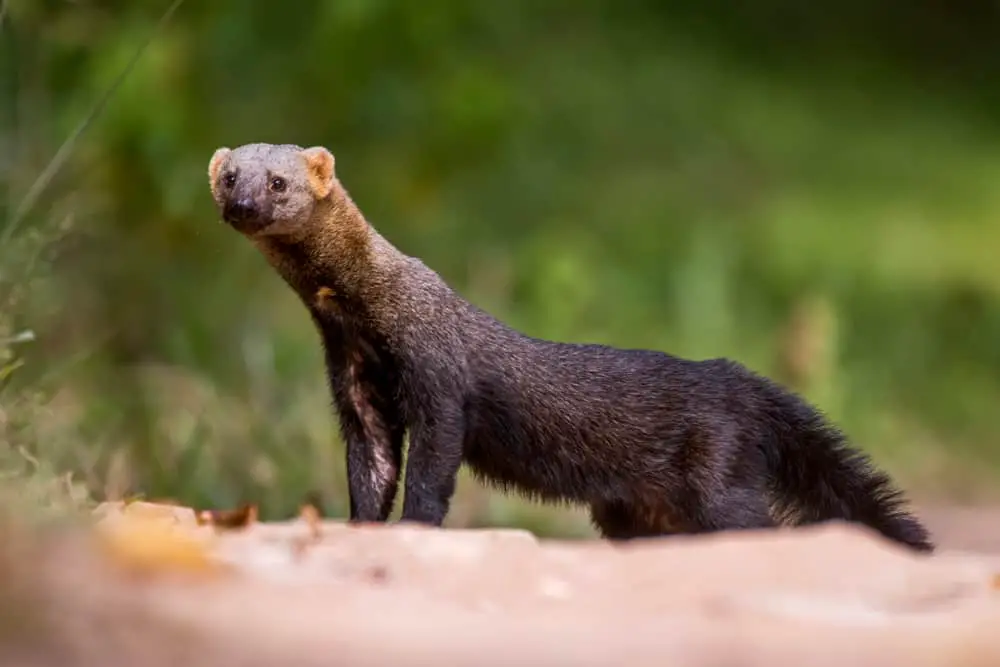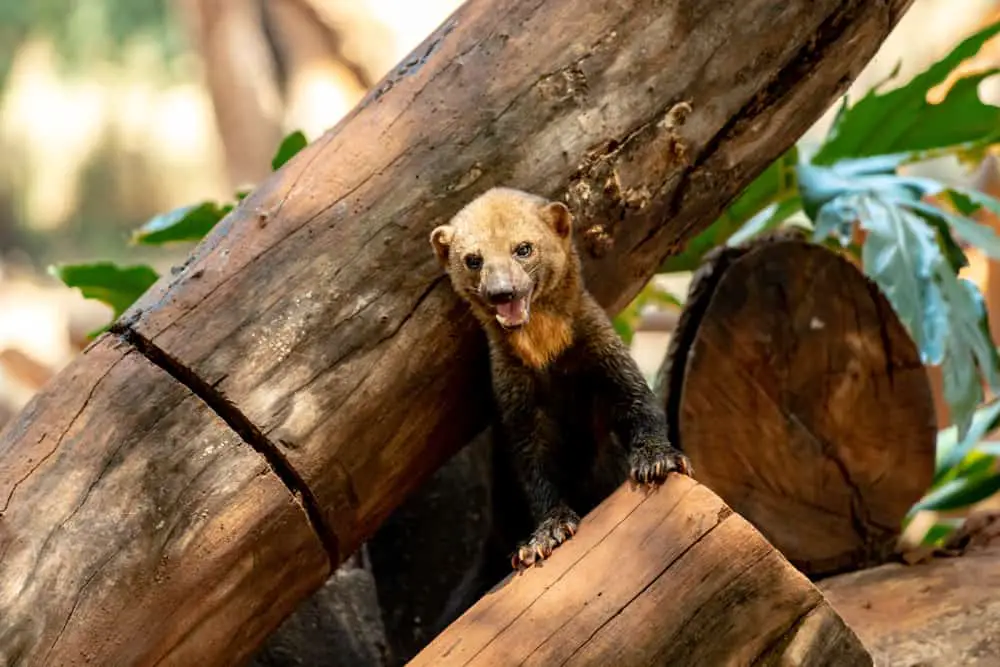Tayra, also known as the Eira barbara, is a species of weasel native to Central and South America. It is a nocturnal mammal that inhabits tropical rainforests and humid montane forests up to 4500 meters in elevation.
Tayras are adaptable animals with an omnivorous diet consisting mainly of fruit, insects, small vertebrates such as lizards, mice, birds and eggs. They are solitary creatures that live in dens dug out from tree trunks or dense vegetation.
This article provides an overview of tayra behavior and ecology by examining its characteristics, habitat preferences, foraging strategies and population trends. The aim is to provide readers with an insight into this fascinating species so that they can appreciate both its uniqueness and importance within ecosystems across Latin America.
Furthermore, the article will explore how human activities have impacted on the distribution and abundance of tayras over time. Conservation efforts currently being put in place in order to protect these animals will also be discussed. With their wide range spanning many different habitats throughout Central and South America; understanding more about tayras is essential if we are to maintain healthy populations in years to come.

Characteristics
The tayra is a medium-sized mammal, easily identified by its striped coat. It has a long tail and bushy tuft at the end which acts as an aid when climbing. Its agility in trees makes it one of the most sought after animals to observe in tropical forests.
The tayra also displays nocturnal activity, making it difficult to find during daylight hours. It is omnivorous but prefers fruits and small creatures such as insects, birds or rodents for food. While usually solitary, they may occasionally gather together to hunt or travel in pairs or even groups of up to eight individuals.
Its behavior can be hard to predict; with both shyness and boldness being exhibited depending on the situation. They are also known for their ability to recognize danger quickly and flee from predators without much warning. As a result, observing this animal requires patience, knowledge about its natural environment, and skillful observation techniques.
Habitat
The tayra is a versatile species that can be found in many different habitats. To really understand the habits of this mammal, one must explore its various living environments.
To start off with, the most common habitat for the tayra is rainforest. This natural environment provides ample cover and food sources for this animal to survive and thrive in. They are also known to nest high up in trees as well as on the ground making them experts at adapting their lifestyle.
When it comes to mountains, these mammals typically stick close to mountainous streams or rivers where they find plenty of vegetation and water resources. Additionally, they tend to avoid heavily wooded areas since they prefer more open spaces when searching for food.
Finally, savannahs provide yet another popular home for tayras due to the abundance of small rodents that live there. As carnivores, they often hunt during night time hours when temperatures are cooler and prey is easier to spot from higher vantage points such as tree branches or rocky outcrops.
Tayras may inhabit any one of these four distinct habitats: rainforest, mountain, riverbank and savannah – each offering an array of unique characteristics that suit their needs perfectly! With a varied diet including insects, small animals, birds’ eggs and fruit; this adaptable creature has been able to successfully make use of multiple ecological niches ensuring its survival throughout history.
Diet
Tayras are omnivorous mammals, meaning they consume both plant and animal-based foods. Their diet consists of a variety of fruits, insects, rodents and birds depending on the species.
Fruits provide tayras with carbohydrates, vitamins and minerals that are essential to their health. These include bananas, papayas, mangos and avocados which can be found in tropical climates where tayras live. Fruit is an important part of any tayra’s diet since it provides them with high levels of energy.
Insects are also part of the tayra’s natural diet as they contain high amounts of protein, fat and other nutrients vital for survival. Insects commonly eaten by tayras include beetles, ants and grubs. Rodents such as mice or rats serve as important sources of proteins for some species while birds like parakeets offer up eggs which provide valuable vitamins and minerals to supplement the rest of their food intake.
Since most wild tayras live in rainforests or other heavily forested areas, these animals rely on all types of food sources available to them to maintain good nutrition throughout life stages from infancy to adulthood. Understanding what a balanced diet looks like for this species is key for researchers looking at ways to preserve populations in captivity or in the wild.
Reproduction
The reproductive habits of the tayra provide an interesting study in mammalian behavior. As with many mammals, a pair of tayras mate for life and begin breeding when they reach maturity at around two years old. During mating season, which occurs annually between April and June, male and female tayras perform courtship rituals to demonstrate their interest in one another.
These rituals involve chirping vocalizations as well as physical displays such as tail flicking and rubbing noses together.
Once mated, the gestation period lasts approximately seven weeks before the female gives birth to a litter of young known as pups or cubs. Typically, this litter numbers four to six pups although sometimes more are born depending on environmental factors such as food availability and climate conditions.
The parents share parental duties during the first few weeks after birth while their offspring nurse from them both. After about three months of age, the young become independent and strike out on their own.
In terms of nesting behavior, it is important to note that unlike some other species of mammals, tayras do not migrate or hibernate but instead remain active year-round throughout Central America where they create dens near rivers or streams. This allows them access to water sources needed by both adults and young alike when constructing nests made of twigs lined with leaves in trees or caves located close by.
| Breeding Behavior | Mating Rituals | Gestation Period | Clutch Size | Year-Round Nesting |
|---|---|---|---|---|
| Life Long Mate | Chirp Vocalizing & Tail Flicking/Rubbing Noses Together | Seven Weeks | 4-6 Pups | Near Rivers/Streams |
Conservation Status
The tayra is an endangered species, with its population in decline due to habitat loss and illegal hunting. Conservation efforts have been initiated by various organizations to help protect the tayra from extinction. These include conservation projects that focus on preserving the natural habitats of the animal, as well as providing education about how to coexist with them without posing a danger.
In addition, there are also campaigns aimed at protecting tayras from poachers and other human activities that may contribute to their declining numbers. Organizations such as World Wildlife Fund (WWF) work towards raising awareness of this issue through public outreach events and initiatives. The goal is for people to understand why it is important to protect these animals and become more aware of their existence in our environment.
There has also been success in initiating captive breeding programs for the tayra, which can be used to increase populations in areas where they have disappeared completely or have severely declined due to poaching or habitat destruction. With continued conservation efforts, a brighter future may lie ahead for this unique species so they will not go extinct any time soon.
Interaction With Humans
The tayra’s interactions with humans are complex and varied, depending on the context. In some regions of Central America, the tayra is an integral part of people’s lives; in others, it is a feared pest that raids crops or livestock.
In areas where they have been domesticated, tayras can be used to hunt small game due to their agility and keen senses. They also make excellent guard animals for farms by alerting owners when there are intruders nearby. The relationship between human-tayra interaction ranges from mutual benefit to predation.
On the other hand, when found in natural habitats, tayras may present a problem for farmers as they raid poultry yards or gardens for food sources. Furthermore, uncontrolled hunting by humans has caused significant population decline in many parts of its range. It is important to understand both sides of this dynamic so effective management strategies can be implemented.
Tayra Interaction with Humans:
- Benefits:
- Provides opportunities for hunters/farmers to use them as guard dogs or search & rescue animals
- Can help keep rodent populations under control
- Hazards:
- May prey upon domestic chickens and other farm animals
- Human overharvesting has led to population declines across its native range
It is clear that human-tayra relationships need greater attention if conservation efforts are to succeed in the long term. As such, further research into the specific needs of these species should be conducted, including exploration into potential methods for managing habitat loss and poaching pressure. These actions could provide invaluable insight into how we can better protect this species from extinction while still allowing reasonable levels of exploitation within our societies.

Interesting Facts
Tayras are an interesting species of mammal due to their unique physical and behavioral characteristics. Physically, tayras have a distinct fur coloration that ranges from black to dark brown or reddish-brown. They also possess long bushy tails in contrast to the short stubby tails seen in other mammals. In terms of behavior, tayras tend to be solitary animals but can form small social groups for nesting purposes during certain times of the year.
In terms of climbing ability, tayras are extremely agile and able to climb up trees with ease using their strong claws and muscular hind legs. This agility has enabled them to access sources of food such as bird eggs that would otherwise remain out of reach. Additionally, some populations exhibit tail lengths much longer than others, suggesting they may use this adaptation as a way to navigate through dense vegetation or maintain balance when climbing tall trees.
The combination of physical features and behaviors associated with tayra biology make it an intriguing creature worth observing and studying further. Further investigation into the species’ diet preferences, habitat selection patterns, and social dynamics could provide insight into how these traits evolved over time and what purpose they serve today.
Conclusion
Tayra are remarkable animals with a wide range of characteristics, habitats, diets and reproduction strategies. Their conservation status is not yet fully understood but they have been the focus of various research initiatives in recent years to better understand their population dynamics.
As humans encroach on natural tayra habitats through agricultural expansion or deforestation, understanding how these creatures interact with our species becomes increasingly important.
There is much to be discovered about this fascinating animal which can make for some intriguing facts that may surprise even experienced wildlife enthusiasts.
For example, tayras possess an impressive sense of smell and hearing due to their sensitive whiskers and long ears; despite being nocturnal by nature, they will often venture out during daylight hours in search of food; their agility allows them to climb trees quickly and easily when needed; and lastly, although usually solitary creatures, when necessary they will form small packs to hunt down large prey together.
In conclusion, tayras display many interesting traits that set them apart from other species within the weasel family. With ongoing research efforts into the ecology and behavior of these mammals, scientists hope to gain further insights into how best protect them as human habitation continues to expand worldwide.
By appreciating their unique abilities and understanding more about where they live and what they need to survive, we can ensure that future generations continue to benefit from having tayras around us in all parts of the world.

